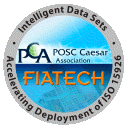| Version 1 (modified by jbourne, 16 years ago) |
|---|
TracNav menu
-
IDS-ADI Projects:
- ISO 15926 Primer
- ISO15926 Standard Structure
- IDS-ADI Coordination Structure
- IDS-ADI Infrastructure
- The AVALON Project
- Core Modelers Projects
- Core Implementers Projects
- Core Compliance Project
- Core Methodology Project
- IDS-ADI Matrix Master (login)
- IDS-ADI Matrix 1,2,3 activity
- IDS-ADI Matrix 4 activity
- IDS-ADI Matrix 8 activity
- IDS-ADI Part3 Harmonization
- IDS-ADI BIDG (aka Handover Guide)
- IDS-ADI Proteus Project

POSC-Caesar FIATECH IDS-ADI Projects
Intelligent Data Sets Accelerating Deployment of ISO15926
Realizing Open Information Interoperability
Models, Meta-Data and Data
The convention when modeling information is to divide it into model and data, where the model is the schema that governs the form of the data and against which it can be validated.
Early Binding
The temptation when implementing a system is to embed all knowledge of the model in the system, but to leave the data free. The problem with this approach is that it does not allow transmission of models, only transmission of data. We term these kinds of system "early-binding" which means that they deal with a fixed model.
Late Binding
In contrast, in a collaborative reference data library, no system can truly embed all knowledge of the model, because the model is always expanding. This means that sometimes, model needs to be transmitted as data. We term these kinds of system "late-binding", which means broadly that they can deal with ad-hoc structures.
Meta-data is Data
To take this a step further, in order to validate data against a model in a late-binding system, all of the meta-data about the described structures also needs to be transmitted as data.
These leads us to the conclusion that meta-data and models are also just data, and since a machine needs to embed knowledge about the structure and meaning of data in order to process it, we are therefore well situated by representing all data in the same way - models and meta-data look just like data to the machine.
The Role of RDF
For the RDS/WIP we have chosen RDF as the common representation because it reduces all information to simple statements of exactly the same form.
